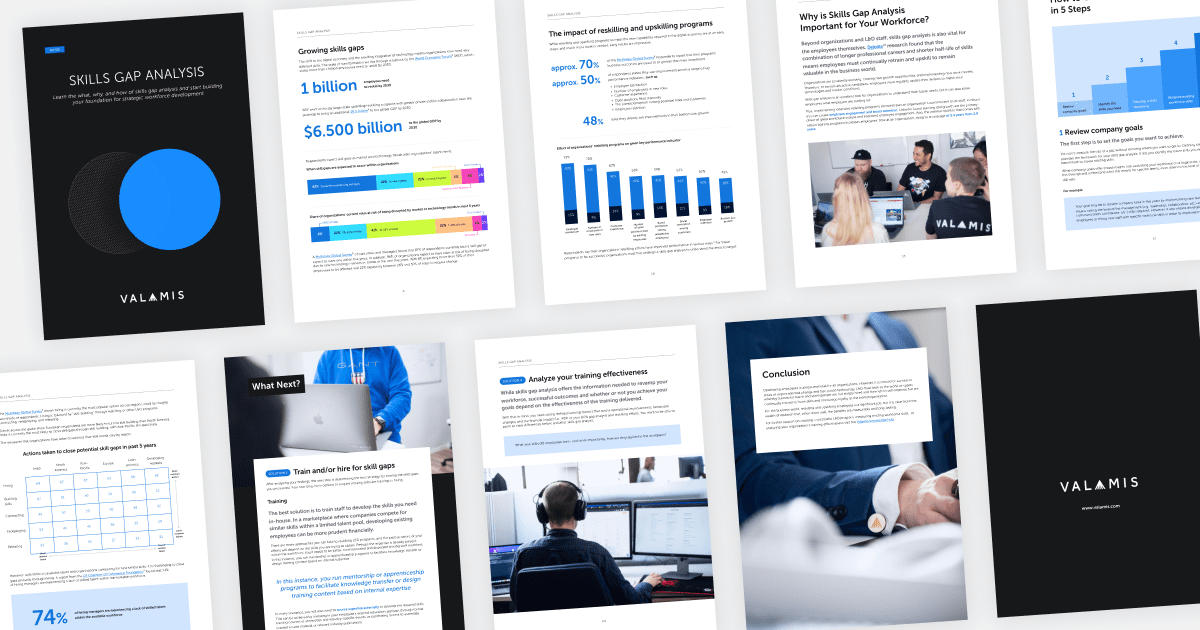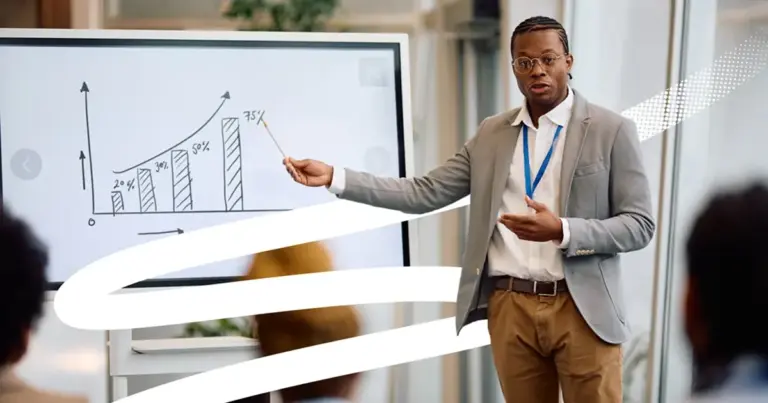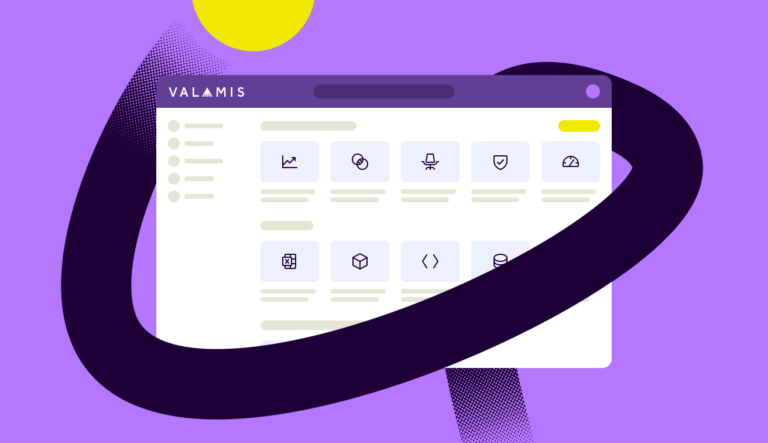Skills Gap
No workforce can be truly effective with underlying skill gaps. In this guide, we’ll cover what skill gaps are, how to identify them, and the best ways to address and close them to build a stronger, future-ready team.
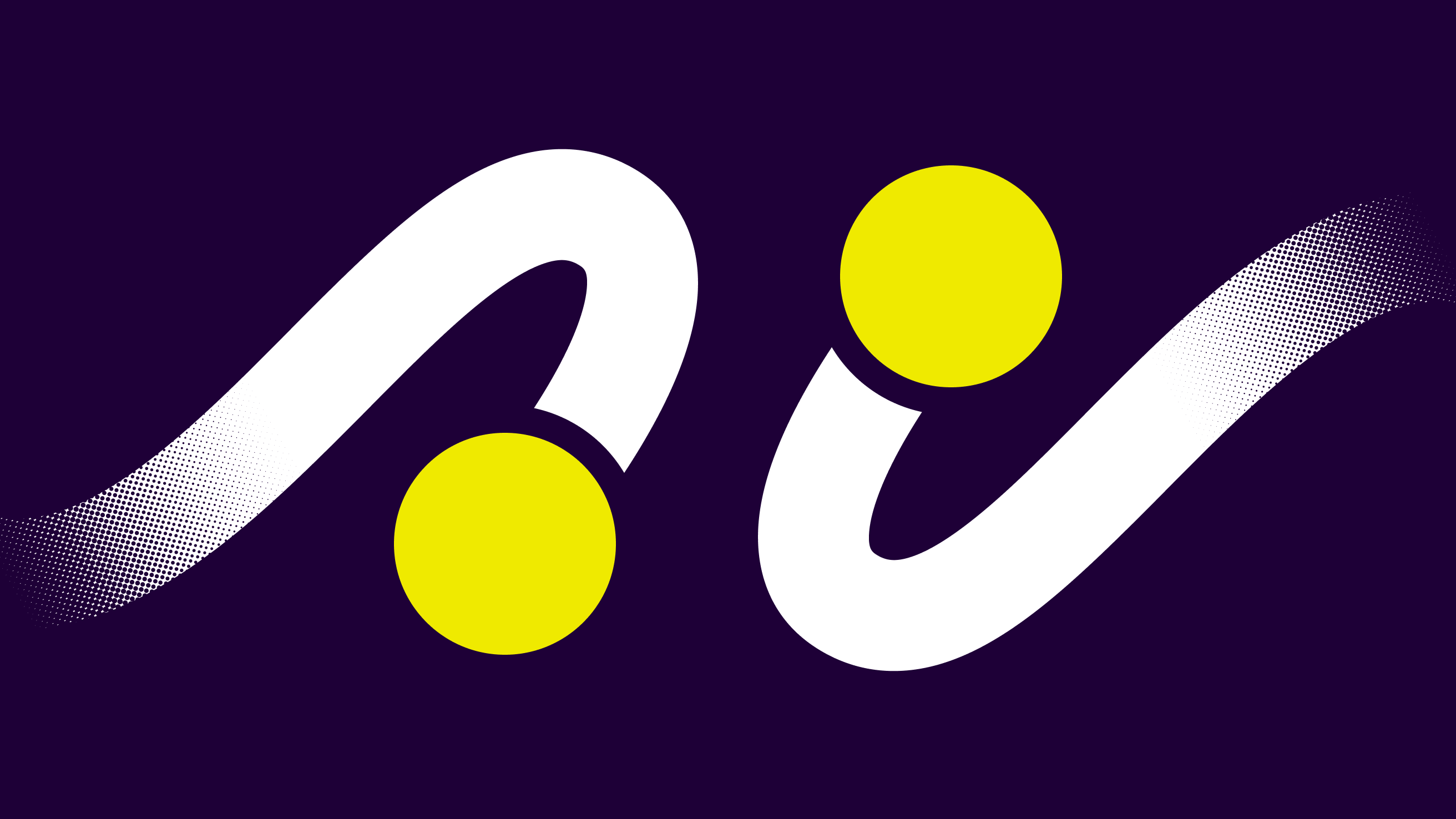
Skill gaps have always been around, but today’s fast-changing digital world makes them harder to ignore.
To build a future-ready workforce, it’s important to first understand what skill gaps are and how they affect your team’s performance.
Once you’ve identified those gaps, you can focus on closing skill gaps with targeted strategies, helping your people develop the expertise they need to keep up with industry demands. By addressing these skill gaps, you’ll set your team up for success and keep your organization moving forward.
Discover:
- What is a skill gap?
- The importance of analyzing skill gaps in your company
- The three types of skills gaps
- Skills gap vs. performance gap. What is the difference?
- Common employees skill gaps (examples)
- The challenges of addressing skills gaps
- How to identify the skills gap
- Resources to address skills gap
What is a skill gap?
A skills gap is the difference between an employee’s current abilities and the skillset best suited for their job.
Companies have a desired set of skills to perform a given role successfully. This list of skills is dynamic and changes depending on external market forces and internal organizational changes.
Finding employees to match the required skills for every position is challenging; therefore, skills gaps exist.
Many factors can contribute to skill gaps:
- A lack of experience
- Inadequate training
- Poor recruitment
- Employee turnover
- Failures in the broader educational system
- Change in roles or responsibilities
Skills gaps can lead to workplace inefficiency, with staff struggling to handle their responsibilities or perform assigned tasks. In addition, severe skill gaps may lead to employees being unable to perform their roles.
In addition to focusing on an individual’s skills gaps, the concept can also be applied at a company-wide level.
Management can use skill gap assessments when introducing new procedures, technologies or take them into consideration when looking at work culture.

How to conduct a skills gap analysis and what to do next
Start building your foundation for strategic workforce development.
Download guideThe importance of identifying skill gaps in your company
Skills gap analysis is a critical tool for organizations to assess the effectiveness of their workforce. Identifying any skills gaps present and understanding how they limit company performance is becoming essential thanks to new technologies transforming many business sectors.
With new technologies finding widespread use across the business world, the need for skills gap analysis is only growing.
At a time when digitization and automation are redefining what companies need from their employees, skills gap analysis offers the roadmap to a better, more efficient way of working.
Even before the pandemic, the World Economic Forum estimated that half of all employees worldwide need reskilling to learn how to operate in the new technology-powered workplace. Skills gap analysis is the key to successful reskilling and upskilling programs and understanding where workforces need to improve.
Identifying any skills gaps present and understanding how they limit company performance is becoming essential thanks to new technologies transforming many business sectors.
With AI, automation, and other advances, many roles are becoming obsolete, and organizations need to source new skills to match growing technological needs. However, research by McKinsey in 2021 shows 87% of organizations expect to experience skills gaps in the coming years, with 43% saying they already have one.
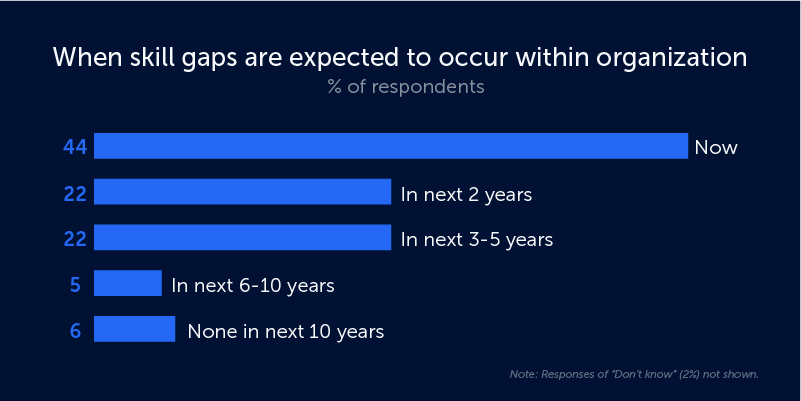
A 2022 survey of CEOs by Deloitte found labor and skills shortages were the 2nd most cited external factor disrupting their business strategy. Also, with the rise of the digital economy, a Salesforce survey found that 76% of global workers don’t feel equipped to operate in new digitally-focused workplaces.
To respond to this gap, organizations must assess their existing workforce and develop active training programs and recruitment strategies to meet the moment.
Benefits of successfully overcoming skills gaps lead to a range of benefits, including:
- Developing a complete understanding of your workforce
- Greater productivity
- Improved agility
- Clear workforce planning strategy
- Competitive advantages over other organizations
The three types of skills gaps
Skills gaps can exist in various forms. However, generally speaking, they can be separated into three main types:
- Knowledge Gap – a lack of knowledge related to the job. This could be the specific knowledge required to perform tasks successfully, the knowledge needed to understand how the work fits in the wider organization, or the institutional knowledge particular to a given organization. Removing knowledge gaps can improve employee performance and collaboration between staff members.
- Skills Gap – while knowledge generally refers to learning information and an individual’s intellect, skills refer to the ability to apply the proper knowledge in a given situation. Whereas employees can pick up knowledge through studying, skills must be performed. The skills needed for a particular job could be mental (e.g., coding ability), physical (e.g., fitness required for a physical role), or soft skills such as communication and emotional intelligence.
- Performance Gap – a lack of motivation or engagement leading to poor performance. Unlike the previous two types, performance gaps occur when an employee with all the tools to be successful underachieves. This could be for several reasons, including poor management or individuals being a bad cultural fit for the organization.

How to conduct a skills gap analysis and what to do next
Start building your foundation for strategic workforce development.
Download guideSkills gap vs. performance gap. What is the difference?
The concept of skills gaps can sometimes be confused with performance gaps. While similar, they describe different root causes for underperforming staff members.
| Skills gaps | Performance gaps |
|---|---|
| Refer to a lack of knowledge, expertise, or skills preventing an employee from maximizing the potential of a given role. | Refer to a lack of motivation or poor management misdirecting an employee’s efforts. |
| Occur when employees need to gain the skills, knowledge, or capabilities to apply them correctly to a given situation. | Occur when employees have the requisite skills but need more motivation or supervision to apply them effectively. |
| Examples could include understanding how an organization operates, how their work fits within wider processes, or the specific skills needed to fulfill the role, e.g., technical knowledge or soft skills. | Examples could include disgruntled employees with personal grievances in the workplace, new hires being a poor cultural fit, or managers failing to assign or oversee tasks correctly. |
Common employees skill gaps (examples)
In 2024, organizations face a variety of skill gaps that are critical to address to maintain competitiveness and productivity. These gaps span both technical (hard) and non-technical skills (soft).
Here’s an overview of the most common skill gaps among employees:
1. Technical skills:
- Data analysis: Many companies have vast amounts of data but lack employees skilled in analyzing this data to drive business decisions. Training in data analytics tools and methodologies is essential. (source)
- AI and machine learning: With the growing use of AI, there’s a significant demand for employees who understand machine learning, AI integration, and AI auditing. (source)
- Cloud computing: As businesses increasingly rely on cloud infrastructure, skills in cloud management, security, and DevOps are in high demand. (Check what are the most in-demand skills for IT and Cloud Computing according to CIO)
- Cybersecurity: According to Springboard report, the rise in cyber threats necessitates expertise in IoT security, threat detection, and cybersecurity policies.
2. Soft skills:
- Project management: Effective project management is crucial, yet many employees lack the skills to plan, execute, and monitor projects efficiently. Training in project management methodologies and tools is necessary.
- Critical thinking and problem-solving: These skills are vital for adapting to the fast-paced business environment, yet they are often lacking. Employees need training that encourages strategic thinking and decision-making.
- Communication and collaboration: With remote work becoming more common, the ability to communicate effectively and collaborate across teams is increasingly important. Training in communication strategies and team dynamics can help bridge this gap.
- Emotional intelligence: Skills such as empathy, self-awareness, and conflict resolution are essential for maintaining a positive workplace culture and are often areas of weakness.
3. Adaptability and flexibility
We have singled this out into a separate category because we see great importance in it.
The ability to adapt to new technologies and processes is critical. Employees need continuous learning opportunities to stay agile and flexible.
4. Creativity and innovation
As industries evolve, companies need employees who can think creatively and innovate. Training programs that encourage creative thinking and the development of innovative solutions are important.
(according to Springboard’s State of the Workforce in 2024 report)
The challenges of addressing skills gaps
While many workforces clearly have a problem, addressing skills gaps is challenging. Research from McKinsey found only 33% of capability-building programs always or often achieve the desired results.
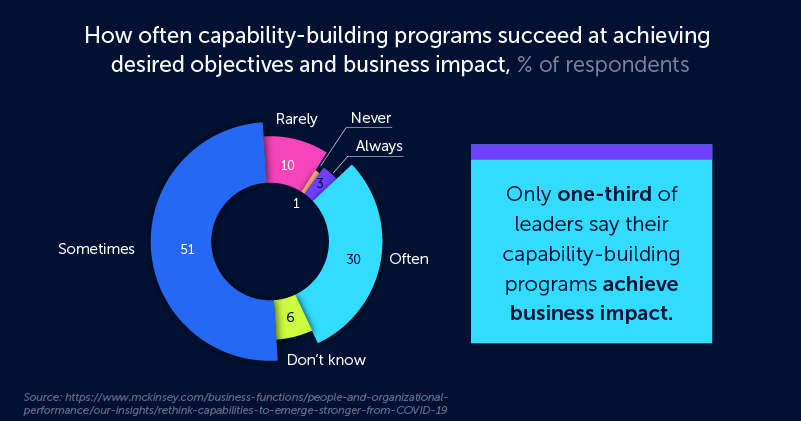
So why is it so hard to overcome workforce skill gaps?
- The same McKinsey research found leadership plays a critical role in the success of skills gap programs,particularly in setting an example for employees. Surveys found that 65% of respondents believe executives should participate in L&D courses as trainers, facilitators, or learners. Leadership buy-in and modeling the same behavior asked of employees improves success rates when addressing skills gaps.
- Whether through training or hiring, overcoming skills gaps costs money. Many organizations want the benefit of an up-to-date productive workforce but are unwilling to make the investments necessary.
- Similarly, many organizations look to take shortcuts when it comes to addressing skills gaps. For example, McKinsey has developed a lengthy process around planning, developing, and implementing infrastructures to retrain employees post Covid. Their research found organizations that follow every step are 2.5x more successful than those that skip just a single stage.
- When looking to remove a workforce skills gap, it is easy to define the objectives; it is much harder to define the journey. Employees like to learn in different ways, and it can be challenging to implement appropriate formats that cater to everyone’s preferences. Whether it is digital learning, group workshops, expert coaching, or one of many other formats, the best skill gap programs are tailored for each employee.
How to identify the skills gap
Identifying this gap is crucial for L&D professionals, as it helps in designing training and development programs that directly address the organization’s needs.
1. Clearly define organizational objectives
Before you can identify a skills gap, you need to understand where the organization is headed.
What are the long-term and short-term goals?
What skills are required to achieve these goals?
Tip: Regularly revisit and revise objectives to reflect changes in the business environment and organizational strategy.
2. Conduct job role analysis
Examine every job role in the organization. Understand its requirements, responsibilities, and the skills necessary for success.
Tip: Involve both upper management and frontline employees in the analysis to ensure a comprehensive understanding of each role.
Check out our latest Skill-based Talent Management article
3. Survey employees and managers
Use questionnaires, feedback forms, or interview sessions to gather insights from employees and their managers about their perceived skills and training needs.
Tip: Utilize anonymous surveys to encourage honest feedback and to ensure that employees feel safe sharing their views.
4. Perform skills assessments
Use online tools (like Valamis), quizzes, or practical tests to evaluate the current skills of employees. Compare the results against the desired skill levels.
Tip: Rotate the types and formats of assessments to cater to different learning styles and reduce the potential for rote learning.
5. Analyze performance metrics
Review performance reviews, project results, and other relevant data to identify areas where employees are falling short.
Tip: Use data visualization tools to spot patterns and trends over time, enabling a more holistic understanding of skill gaps.
Read our recent blogs to gain more insights on the topic: 10 Valuable Training Metrics to Know and How to Measure and Evaluate Training Effectiveness
6. Competency frameworks
Develop or utilize existing competency frameworks that detail the knowledge, skills, and abilities required for each role.
Tip: Benchmark your frameworks against industry standards and continuously update them as the industry evolves.
7. Feedback from external stakeholders
Sometimes clients, suppliers, or other external partners can provide insights into areas where your employees might be lacking.
Tip: Regularly schedule feedback sessions and establish open channels of communication with these stakeholders.
8. Industry benchmarks
Check industry standards and trends. Are there new tools, technologies, or methodologies that are becoming standard? If so, there might be a skills gap.
Tip: Subscribe to industry newsletters, join relevant professional organizations, and actively engage in forums to stay updated.
9. Skill inventory
Maintain an inventory of current employee skills. This database can help in identifying gaps quickly and can be updated annually or semi-annually.
Tip: Incorporate a digital tool or platform that allows real-time updates and easy access for managers across departments.
10. Focus groups
Organize group discussions among employees to understand their challenges, the skills they feel they lack, and areas where they believe training could benefit them.
Tip: Ensure that focus groups are diverse in terms of department, seniority, and demographic to get a broad perspective.
Ways to fill the gap
There are various ways to fill skills gaps and develop a future-proof workforce. This includes training in the form of:
- Reskilling – training employees to transition to a new role
- Upskilling – adding new skills, so an employee improves at their existing role
- Digital training – focusing on the digital skills needed in the modern workforce
Or new hiring practices based on filling existing skills gaps and recruiting better-skilled staff.
Resources to address skill gaps
1. Personalized learning plans
Tailoring learning experiences to individual employees’ needs can significantly improve skill development. Depending on your organization’s resources and needs, you can implement personalized learning plans that cater to individual employee strengths and areas for improvement. Below are some key resources you can include in these plans:
- E-learning platforms: The platforms, like Valamis, offer a flexible, self-paced learning environment where employees can access a variety of courses tailored to their individual needs and skill levels.
- Mentorship programs: Pairing employees with experienced mentors allows for targeted, one-on-one guidance that helps in skill development and career growth.
- Personalized coaching: Focused coaching sessions provide employees with tailored strategies to overcome specific challenges and enhance their skills.
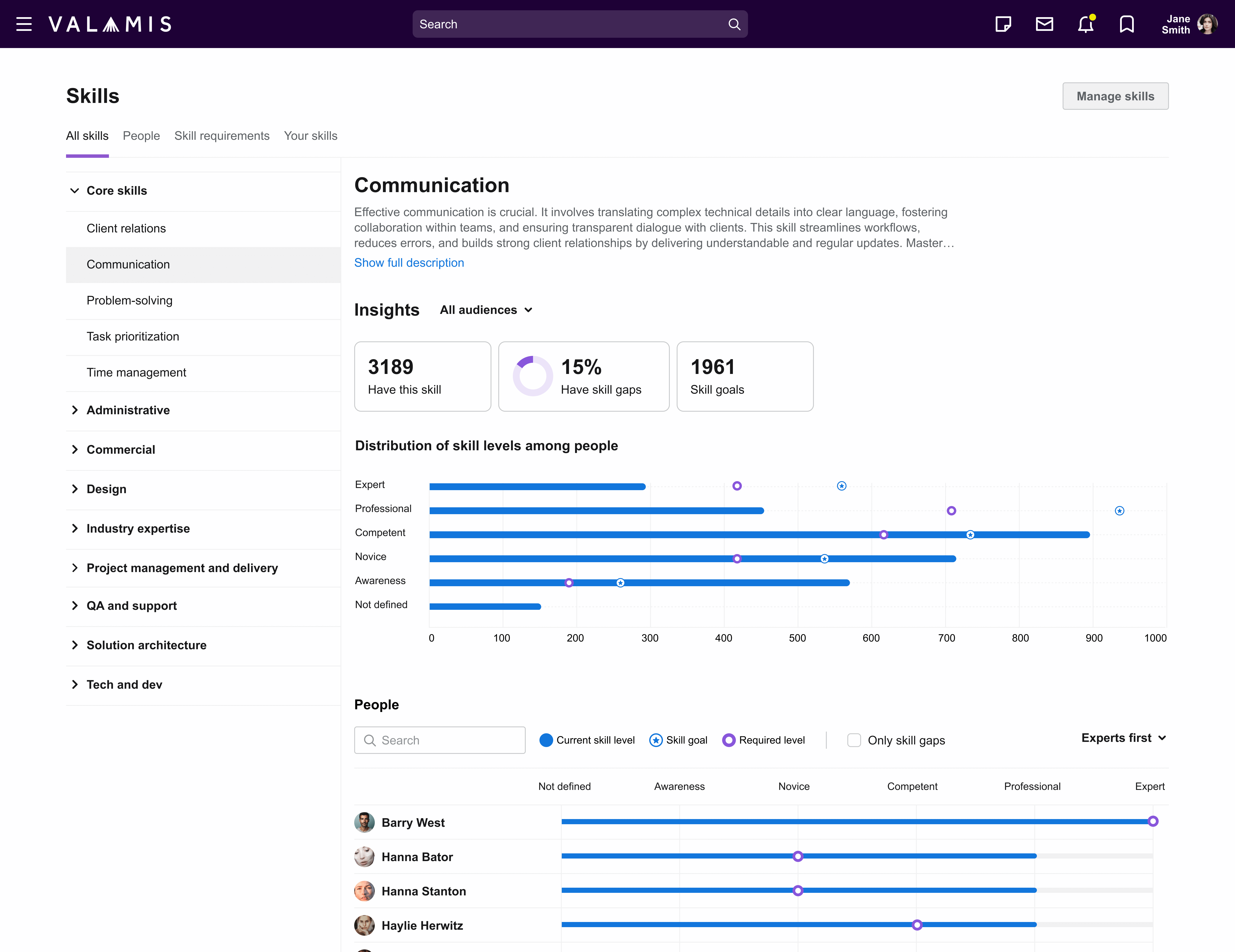
Example of how you can visualize and analyze the skills gap using the Valamis platform
2. On-the-job training
Real-time, hands-on on-the-job training is effective in reinforcing new skills. This can include apprenticeships, job shadowing, and cross-training within the organization.
3. Microlearning
Breaking down learning into small, focused segments can help employees quickly absorb and apply new knowledge, which is particularly useful for busy professionals.
What to do next
Addressing workforce gaps requires extensive skill gap analysis, the process of determining the difference between what an organization needs from its staff and what it currently receives.
Skill gap analysis requires effective HR processes to accurately reflect the performance of employees and identify the skillsets and knowledge currently lacking or underdeveloped.
Check out our article on How to conduct skills gap analysis or download our Skills gap guide.

